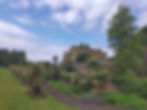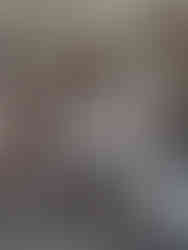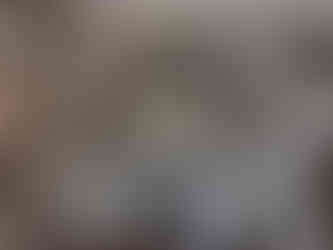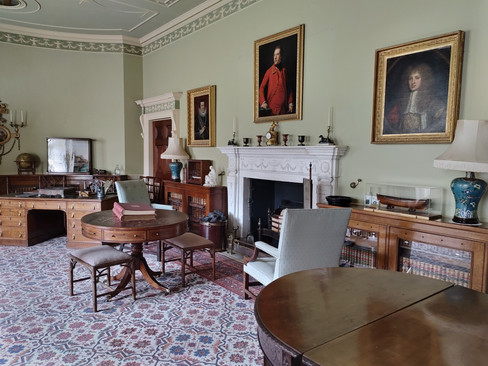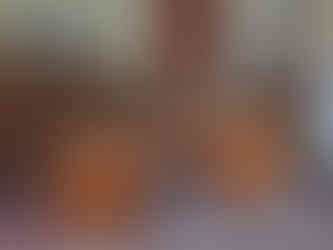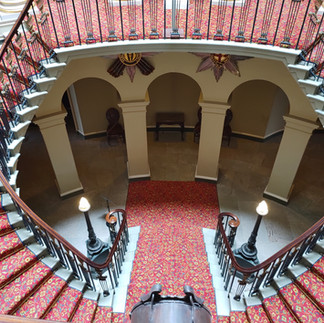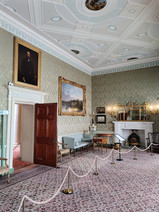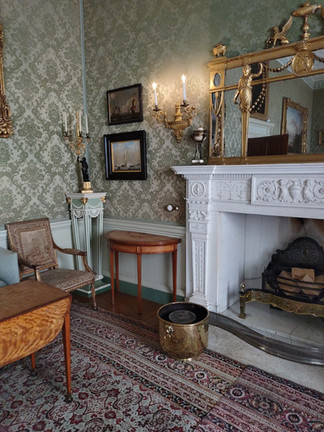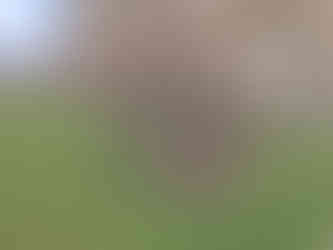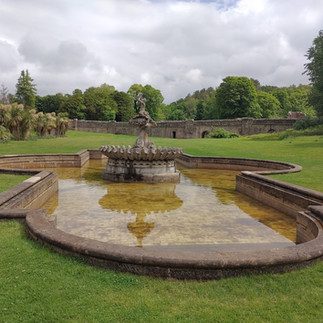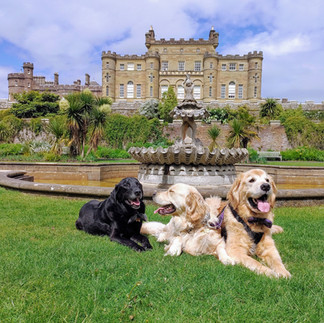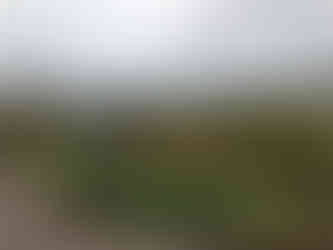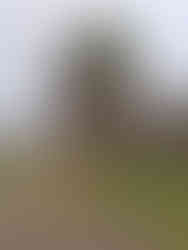Captivating Charm at Culzean Castle and Country Park
- Wee Walking Tours
- Apr 6, 2024
- 9 min read
Updated: Apr 15, 2024
As our very stormy wet winter season has now spilled into an extremely wet spring here in Scotland, I thought it would be nice to take us all back to a sunny, summer day and visit a beautiful castle. However, this isn’t just any castle, it’s one of the grandest in Scotland. Our virtual journey includes exciting adventures that span the centuries with tales of smuggling, a glorious restoration by one of the most famous Scottish architects, and unexpected financial rescue by an American. So, join us as we head to the dramatic cliffs of western Scotland and visit one of the gems in the National Trust for Scotland (NTS) portfolio- Culzean Castle and Country Park!

Before we officially start the article, I just want to point out that this was one of our happiest memories with our three canine angels- Finn, Stirling, and Sawyer (pictured above)- who were fortunate to visit Culzean Country Park before they crossed the Rainbow Bridge. We hope you enjoy this tour and how they feature in some of the photos from that special day.
Humble Beginnings
Culzean (pronounced without the ‘z’- ‘cuh-lain’) Castle didn’t start out as a grand neoclassical masterpiece. Rather, as with most Scottish castles, its origins began with a tower house. According to the NTS, the earliest historical records date to the 1400s and mention a tower house that was then known as “Coif Castle or the House of the Cove, taking its name from the caves below” (more on the fascinating history of the caves in just a moment).
The Kennedys of Culzean owned the Castle for centuries and were one of the oldest families in Scotland. Notably, they were descendants of Robert the Bruce.
Smuggler & Slaver
As did many of his contemporaries, Thomas, the 9th Earl of Cassilis did the ‘Grand Tour’ of the European continent, where he spent years travelling around taking in the stunning history and culture that surrounded him. These travels inspired Earl Thomas and gave him ideas on how to improve Culzean which had become run down.
Juxtaposed with this cultural side was that, when he returned to Culzean, Earl Thomas took part in two questionable ‘trades’. First, he was part of the smuggling or ‘Running Trade’. According to the NTS, the Kennedy’s had been involved in this for centuries as Culzean was situated on the Firth of Clyde which “was the notorious centre for smuggling”. Furthermore, there were fortified caves beneath Culzean “that were ideal for hiding contraband from the Revenue officers”.
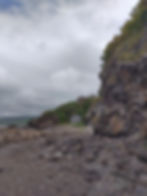
Interestingly, Earl Thomas was a fervent Jacobite and supported the return of the Stuart royal family to the throne. Therefore, in addition to the clear financial benefit, he (and others like him) also took part in the smuggling trade as a way of expressing “their defiance of the Hanoverian government”. The Kennedy’s support for the Stuart family goes back to the time of Mary Queen of Scots when it is said that, Jean, the sister of the 4th Earl, was the one who had the sad responsibility of tying the scarf around Mary’s eyes right before she was executed.
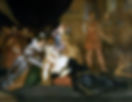
Unfortunately, when the Running Trade became too risky for a man of his status, Earl Thomas decided to turn to the slave trade. Thus, we agree with the NTS that it is crucial that we point out that his activities in the slave trade significantly increased the income of the estate. We love travelling around Scotland and learning about its incredible history, but we also recognise that many of the opulent houses, castles, and palaces also have a historical connection to the slave trade that contributed to the creation of such unbelievable wealth. Therefore, we believe that we can provide a more complete understanding of Scotland’s complex history by revealing these connections when they are known.
Grand Aspirations
When Thomas died in 1775, his brother, David, inherited Culzean and became the 10th Earl of Cassillis. Earl David had impressive ambitions for Culzean, and he hired master architect, Robert Adam, to set about transforming Culzean Castle into a neoclassical grand country house.
Robert Adam was born in Fife, Scotland and went into the family architecture business. Early in his career, most of his projects were in England and, according to the NTS, were characterised by a rich, ornamental style influenced by “classical forms he had studied in Italy and in Split but with elements of Greek, Gothic and even Egyptian architecture”.
Adam eventually made his way back to Scotland, but, by that point, his style shifted to a “simpler, more dramatic castle style which drew on traditional Scottish, Ancient Roman, medieval and Renaissance architecture”. This is the style that he used for Culzean while he worked on rebuilding it during the 1770s-1780s. Sadly, Robert Adam didn’t see Culzean finished as he died at his home in London in 1792.
American Money to the Rescue
Unfortunately, Earl David pretty much bankrupted the estate with his grand aspirations. However, he had the foresight to entail a long-lost Kennedy relative to be his heir- a man who just happened to be born in the American colonies in New York- Archibald Kennedy. However, unlike our recent blog friend, Alexander Hamilton, Archibald remained a Loyalist to the British crown.
In fact, Archibald served in the Royal Navy and by 1763 was the “second most senior British officer in North America and played a key role in the events that led up to the American War of Independence”. His house on No. 1 Broadway served as the British Headquarters when the War for Independence began. By 1781, the British had unofficially lost the American War of Independence (it would become official in 1783), and Archibald and his family left New York for London. Of note, George Washington used the Kennedy mansion as his New York City headquarters during the American Revolutionary War. Later, after the War of 1812, Archibald Kennedy's mansion was converted into the Washington Hotel (pictured below).

Archibald inherited Culzean in 1792 and became the 11th Earl of Cassillis. By that time, he had accumulated great wealth thanks to the fortunes from both of his wives who had been wealthy American merchant heiresses. Therefore, it is quite interesting to note that, like the situation at Floors Castle, Culzean Castle was also saved by American money. Sadly, Archibald didn’t live long enough to enjoy Culzean as he died in 1794 and it was then passed on to his son who also had the name Archibald. Fortunately, the 12th Earl had the “energy and resources to bring Robert Adam’s vision for Culzean to fruition”. The NTS points out that he was also “extremely ambitious”. Eventually his political manoeuvring helped him to be named ‘Baron Ailsa’ and eventually the 1st Marquess of Ailsa.
A Gift to the Nation
In more recent history, the 4th Marquess of Ailsa (also Archibald) realised that something needed to be done to secure the future of Culzean and the Kenney family’s history as he didn’t have any heirs and neither did his brother. He approached the newly formed National Trust for Scotland about handing the Castle over to the nation, but died before a decision was met.
Hope was not lost as the 5th Marquess decided to go through with his brother’s wishes. Therefore, in 1945, representatives from the Kennedy family and the NTS met. The NTS states that “Lady Frances, the widow of the 4th Marquess, did most of the negotiating and agreement was reached to hand over the castle, the policies, the gardens and the Home Farm to the Trust”. Furthermore, “the Marquess was keen that the top floor of the castle should be converted into a flat for use of General Eisenhower as a gesture of Scottish thanks for America’s support during World War II. It was also stipulated that Lady Frances should have lifetime use of the west wing”. All parties agreed to the term and the NTS officially took over Culzean in 1945.
We are so fortunate that the NTS took care of this exquisite historic home- especially because many homes during this time period were left to crumble into ruins or even torn down. So, with some of the history established, let’s begin our tour of Culzean Castle and Grounds as they are today.
Culzean Castle and Grounds Today
The approach to Culzean Castle was designed by Robert Adam to be an experience. I can confirm that the 'wow' factor is definitely there, but you really need to see it in person to get the full experience; hopefully our photos and video do it some justice. One of the first structures you come across is the Ruined Arch which was designed by Robert Adam to create more atmospheric effect. You then walk across Adams' Viaduct.
For our visit, I chose to start with a tour of the inside of the Castle and then did an exploration of the grounds. Therefore, lets head inside and see a bit how it looks today. Entering Culzean Castle you first come into the Porch and then the Armoury.
What is now known as the Library was originally designed as ‘The Old Eating Room’.
The Dining Room was built by the 3rd Marquess as part of his alterations to Culzean Castle in 1877.

The Oval Staircase is a showpiece feature of the Castle and it's magnificent design is thanks to Robert Adam.
The Oval Staircase leads to one of my favourite rooms in the house, the Round Drawing Room, which was also designed by Robert Adam. The views out to the Ayrshire coast are breath-taking.
The State Bedroom:
The Blue Drawing Room is where guests would have gathered for drinks before dinner. The painting is of Sir Thomas, the 9th Earl.
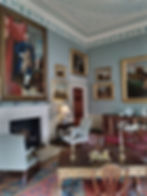
The Long Drawing Room was originally the Great Hall of the medieval castle. It now displays some of the Castle’s finest art and features a nautical theme which reflects the family’s connection to the sea. For example, the two exquisite landscape paintings with views of Culzean (as seen in the pictures below to the left and middle) were done by the famous Scottish painter, Alexander Nasmyth.
The 3rd Marquess and his first wife, Evelyn (Lady Ailsa), moved to Culzean Castle to raise their family there. Up to this point, over the centuries, Culzean was mostly only used seasonally or when the family were in financial dire straits. Starting in the 1870’s, the 3rd Marquess had the Castle renovated to better suit more full-time family living. This led to the creation of what is now known as Lady Ailsa’s Boudoir, Dressing Room, Wardrobe Room, Bathroom, and Family Bedroom. He also had the West Wing built and this is where the children’s rooms were located.
As I mentioned above, General Eisenhower (later President Eisenhower) was given a flat (apartment) at Culzean Castle. Starting in 1946, he visited throughout the years and used it as a holiday home in Scotland. His last stay was in August 1962.
Eisenhower's apartment is now a hotel owned and run by the National Trust for Scotland. Therefore, if you are feeling 'presidential' you, too, can stay at the Eisenhower apartment. Below are some of the artefacts on display that were once used by Eisenhower at Culzean Castle.
The kitchen, as pictured below, is the original built by Robert Adam in 1777 and was used for almost 100 years until the 3rd Marquess had a newer, more modernised kitchen built in the West Wing.
While it has been wonderful to tour the house, we still have so much more to check out on the expansive grounds. Finn, Sawyer, and Stirling have been waiting for you, so let’s go join them!
In 1969, the grounds of Culzean Castle were declared Scotland’s first Country Park. They are simply stunning and cover over “600 acres of woodland, formal gardens and important architecture as well as three miles of varied coastline”. Therefore, be sure to leave time during your visit for a wander about.
Our tour of the grounds starts close to the house.
Pictured below is the Servant’s Walk. This was used by the servants and tradesmen so as to approach the Castle without being seen by the family or their guests.


Let's head down to the Fountain Court.

Finn and Sawyer were looking very happy and dapper in their bow ties.
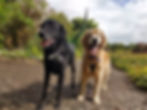
According to the NTS, the Walled Garden with its kitchen and pleasure gardens were first laid out between 1775-1786.
The National Trust for Scotland points out that "great dynasties like the Kennedy family were sustained by their relationship with the land."..."They derived their income from renting out the land to tenant farmers, keeping one farm to provide food for the household." In fact, "Culzean was always almost totally self-sufficient in food production". For example, the Home Farm provided food for the whole house and sold the surplus locally. This is also where the farm workers held offices.
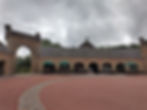
Sawyer didn’t seem to know what to make of the willow ‘sea monster’ sculpture in the Swan Pond. 😂
Keep an eye out as you walk around the expansive woodlands and coastline for some fascinating historic buildings. The Pagoda building (below) was built around 1816 and was refurbished in 1998.

The Powder House (aka the magazine) was purposely kept a safe distance from the Castle.
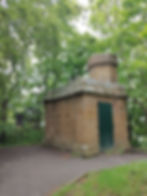
When you make your way down to the Beach, you can see the old Gas House which, starting in the 1870’s, was modernised to provide all heating and lighting for the Castle. According to the NTS, it fell into disrepair after Culzean Castle was connected to electricity in the 1950s, but was restored in 1993.

The building pictured below to the left is The Dolphin House. It was built as the laundry in the 1840s. The Round House is the small stone structure to the right. It was also built in the early 1800s as a small changing hut on the beach "to enjoy the new fashion for sea-bathing”.

Of course, the natural surroundings found throughout Culzean Country Park are beautiful in their own right.
Well, that’s going to do it for this blog post, and we hope you have enjoyed your tour. However, there is so much more to see and learn about Culzean Castle and Country Park. Therefore, we highly recommend that you put this iconic house on your must-see list when you come to Scotland. Please visit the National Trust’s website for more information on how to best plan your visit.
Until next time- Explore & Discover!
